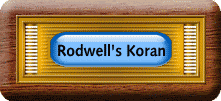|
It would actually be nice if Mohammed could be shown to have been an adherent of
Ptolemaic astronomy with its seven heavens, because that is a
respectable scientific system. I wonder if, instead, he just copied
the idea without really understanding it, as he copied so much else
in a 'monkey-see-monkey-do' unthinking mode. Looking at the 'miry
fount,' it is hard to believe he was anything but a flat-earther at heart.
Probably he tried to take in what he was being taught, perhaps by
preceptors who did not really understand it themselves, but simply
failed.

Tent-Stakes
Mohammed seems stuck on the idea of the earth being...stuck, weighted down by all those mountains:
"Without pillars that can be seen hath He created the heavens, and on the earth hath thrown mountains lest it should move
with you; and He hath scattered over it animals of every sort..." (Sura 31:9);
"And He hath thrown firm mountains on the earth, lest it move with you; and rivers and paths for your guidance..."
(Sura 16:15).
"Have we not made the Earth a couch? And the mountains its tent-stakes?"
(Sura 78:6-7).
"And we set mountains on the earth lest it should move with them,
and we made on it broad passages between them as routes for their guidance..."
(Sura 21:32).
Somebody better get a crow-bar and pry off all those mountains so it can orbit...

The Sky is Falling
- "And should they see a fragment of the heaven falling
down, they would say, 'It is only a dense cloud.'" (Sura 52:44)
- "Seest thou not that God hath put under you whatever
is in the earth...And He holdeth back the heaven that it fall not on the earth,
unless He permit it! for God is right Gracious to mankind, Merciful." (Sura 22:64)
- "And they will say, 'By no means will we believe
on thee till thou cause a fountain to gush forth for us from the earth...Or
thou make the heaven to fall on us, as thou hast given out, in pieces; or thou
bring God and the angels to vouch for thee...'" (Sura 17:92-94)
- "'Make now a part of the heaven to fall down upon
us, if thou art a man of truth.'" (Sura 26:187)
- "What! have they never contemplated that which is
before them and behind them, the Heaven and the Earth? If such were our pleasure,
we could sink them into that Earth, or cause a portion of that Heaven to fall
upon them! herein truly is a sign for our every returning servant." (Sura 34:9).
|
|
Mohammed's fretting about the sky falling does not sound as if intended
as irony. The Kaabah, the sacred structure about which Muslim pilgrims
circumambulate, contains, it is said, a black stone which appears to be
a meteorite. Evidently this stone had long been held in reverence; the
Christian author Clement of Alexandria, writing in the early third century,
mentions it: "In ancient times, then, the Scythians used to worship
the dagger, the Arabians their sacred stone, the Persians their river."
(Clement of Alexandria, Exhortation to the Greeks, Chapter III, p. 101
Loeb edition). Pagan theologian Maximus of Tyre was aware of it, whether
this is the same rock or a similar one: "The Arabians, indeed,
venerate a god whom I do not know; but the statue of him which I
have seen is a quadrangular stone." (Maximus of Tyre, The
Dissertations, Volume II, Dissertation XXVIII, p. 194). These authors wrote centuries before Mohammed.
Muslim sources confirm that the pre-Islamic Arabs worshipped stones:
"Narrated Abu Raja Al-Utaridi: We used to worship
stones, and when we found a better stone than the first one,
we would throw the first one and take the latter, but if we
could not get a stone then we would collect some earth (i.e.
soil) and then bring a sheep and milk that sheep over it, and
perform the Tawaf around it." (Hadith,
Sahih al-Bukhari, Volume 5, Book 59, Number 661).
It is a dramatic and surprising fact that, from time to time,
a rock falls from the sky. Ancient people often responded with
veneration and awe. And what if the whole structure comes down? The fear that a chunk of sky was likely to fall down and
clobber the innocent pedestrian, an odd fear to our ears, was in
fact expressed by other peoples of antiquity:
"Ptolemy, the son of Lagus, relates that in this
campaign the Celts who dwell on the Adriatic came to Alexander
for the purpose of making a treaty of friendship and mutual
hospitality, and that the king received them n a friendly way,
and asked them, while drinking, what might be the chief object of
their dread, supposing that they would say it was he; but that
they replied, it was no man, only they felt some alarm lest the
heavens should on some occasion or other fall on them, but that
they valued the friendship of such a man as him above every
thing." (Strabo, Geography, Book VII, Chapter III, Section 8, pp.
463-464).
Arrian also tells the story of the fearful Celts: "Of the Celts
he enquired what, of mortal things, they most dreaded, hoping that
his own great name had reached as far as the Celts and farther, and
that they would confess that they dreaded him beyond all else. Their
answer, however, proved unexpected to him, for, living as they did
in difficult country far from Alexander, and seeing that his
invasion was really directed elsewhere, they said that their
greatest dread was lest the sky should fall upon them." (Arrian,
Anabasis, Book I, Chapter IV). Did they seriously fear this outcome,
or was this an ironical sally directed at Alexander's inflated
self-estimation?
Evidently the celebrated oracle at Delphi considered this
eventually something to plan for:
"Podaleirios came to Delphi and asked the oracle
where he should settle. An oracle was given that he should live
in a city where nothing would happen to him if the sky above
fell, so he settled the place in the Carian Chersonesos that is
encircled entirely by mountains." (Apollodorus, Library, Epitome
6.18, p. 87 Hackett).


The Hadith
The recollections of Mohammed's contemporaries are employed in working
up Muslim law, because the Koran's scattershot injunctions do not make
up a complete law-code. The sects differ as to the authenticity of the
material in the traditional collections. These 'hadith' also touch upon astronomy:
"Narrated Abu Dhar: 'The Prophet asked me at sunset, "Do you
know where the sun goes (at the time of sunset)?" I replied, "Allah
and His Apostle know better." He said, "It goes (i.e. travels)
till it prostrates Itself underneath the Throne and takes the permission
to rise again, and it is permitted and then (a time will come when) it
will be about to prostrate itself but its prostration will not be accepted,
and it will ask permission to go on its course but it will not be permitted,
but it will be ordered to return whence it has come and so it will rise
in the west. And that is the interpretation of the Statement of Allah:
"And the sun Runs its fixed course For a term (decreed). that is The
Decree of (Allah) The Exalted in Might, The All-Knowing."'"
(Hadith, Sahih Bukhari, Volume 4, Book 54, Number 421.)

|









